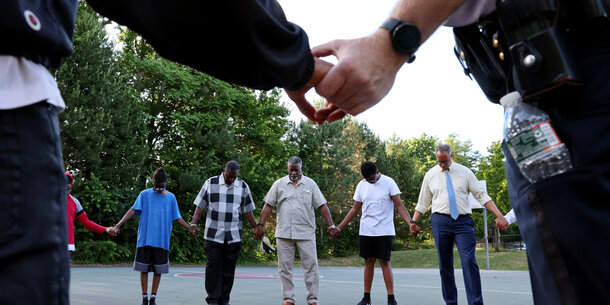In June 2024, the Department of Justice released its fourth annual report assessing the impact and effectiveness of the First Step Act of 2018. This landmark legislation aimed to mitigate the harsh sentencing practices that fueled the mass incarceration crisis in the United States, as well as introduce critical reforms to improve conditions within federal prisons.
Supported by a bipartisan slate of federal lawmakers, the First Step Act represented not just a legislative achievement but a systemic shift toward a belief in second chances. After passage, Sen. Dick Durbin (D-IL) said the law would “begin to relieve our overcrowded prisons, redirect funding to our most pressing crime prevention efforts, make our communities safer, and ensure the integrity of our justice system.” How has the legislation fared in achieving its intended goals? While it has made significant progress in the six years since it was enacted, its effectiveness has been somewhat limited by ongoing legal debates about how it should be applied.
Key Changes Under the First Step Act
Sentencing Reforms
The First Step Act includes key sentencing reforms aimed at reducing lengthy and disproportionate sentences for nonviolent drug offenses while establishing incentives for rehabilitative programming in federal prisons.
First, it made retroactive the Fair Sentencing Act, a 2010 law reducing penalties for crack cocaine offenses that had rightly come to be viewed as outdated, unnecessarily punitive, and discriminatory. This change allowed people sentenced under the prior 100:1 crack cocaine/powder cocaine disparity — which treated 1 gram of crack cocaine, a substance more prevalent in Black and low-income communities, as equivalent to 100 grams of powder cocaine — to apply for resentencing under the new 18:1 rubric.
The First Step Act also restricted the use of enhanced mandatory minimum penalties for certain drug offenses. It did so by expanding an existing “safety valve,” providing judges greater discretion to deviate from mandatory minimums and impose more lenient sentences in certain nonviolent drug offenses if warranted.
Additionally, people in federal prison can now petition a federal court for a sentence reduction under the “compassionate release” statute, allowing them to seek early release due to “extraordinary or compelling circumstances,” which prison authorities have interpreted to include severe medical conditions as well as family emergencies. Previously, only the director of the Bureau of Prisons could file these motions, an action that was rarely taken.
Prison Reforms
The First Step Act’s prison reforms aimed to expand options for meaningful programming and rehabilitation in federal prisons. The legislation provided funding to enhance evidence-based programs in federal prisons, such as drug treatment, vocational training, and literacy skill development. These programs target identified needs, and evaluations have shown them to reduce or likely reduce recidivism.
A system of earned time credits was created to incentivize participation in rehabilitation programs, allowing eligible people to gain credits toward an early transfer to home confinement, community supervision, or residential reentry centers. A second credit system known as “good time” credits, which provide for sentence reductions to reward behavior defined as “exemplary compliance with institutional disciplinary behaviors,” was also expanded to allow people to earn more days per year.
A separate series of provisions helps those who are incarcerated reconnect with their loved ones and establish support systems in preparation for reentry — for example, by helping ensure that people are incarcerated closer to where they will eventually be released.
Additionally, the First Step Act worked to curb certain inhumane practices within federal prisons by creating a de-escalation program that trains staff to manage conflict using nonviolent methods. Importantly, the law also eliminated the shackling of pregnant women.
Evaluating the Progress of the First Step Act
The law’s sentencing reforms have already had a substantial impact. As of January 2024, over 4,000 people had their sentences reduced due to the First Step Act’s retroactive application of the Fair Sentencing Act. The expansion of judicial discretion in certain drug cases affected approximately 1,400 people within a year of its enactment. Changes to compassionate release also allowed for the release of more than 2,600 people during the Covid-19 pandemic.
Prison reforms are more difficult to measure, but the most recent annual report on the First Step Act offers some insight. The law has significantly expanded educational programming in federal prisons, making 112 programs available across all institutions, supported by 385 newly funded filled positions, including psychologists, educators, medical providers, and program staff. This increase in resources, along with the new incentives to participate, resulted in 443,569 program completions as of January 2024 — an increase of over 200,000 from October 2022. Additionally, participation in medication-assisted treatment, a means of treating substance abuse disorder, has surged by 200 percent since October 2023, with more than 68,000 people engaged in drug treatment during fiscal year 2023. To further support successful reentry, over 9,000 people were transferred to facilities closer to their intended communities of release from 2019 to 2023 and 129,616 adults were released to residential reentry centers or home confinement due to earned credits.
These changes have improved public safety. With over 44,000 people released under the First Step Act, the recidivism rate for this group stands at 9.7 percent, compared to 46.2 percent for all people released from Bureau of Prisons facilities in 2018. Though it’s worth noting that these populations differ, this decrease is encouraging.
Obstacles and Legal Debate
Despite these achievements, operational challenges in executing releases and ongoing legal debates about the law’s implementation have blunted its effectiveness. For example, a lack of bed space has led the agency to delay or deny some transfers to transitional housing, which can provide temporary accommodation and support services for people returning to the community after incarceration. And a list of disqualifying offenses has rendered almost 59,000 people ineligible for earned time credits.
Three recent U.S. Supreme Court cases have further shaped the First Step Act’s implementation. In a unanimous 2021 decision, the Court ruled in Terry v. United States that the law allows for retroactive sentence reductions only for those sentenced under mandatory minimums, excluding some possession cases.
In its 2022 decision in Concepcion v. United States, the Court affirmed judges’ discretion to consider other changes in law when resentencing under the First Step Act, offering potential relief to those serving long prison terms under outdated laws. Conversely, in Pulsifer v. United States, decided in March, the Court limited federal judges’ discretion to depart from mandatory minimums for certain drug offenses under the “safety valve” provision, potentially denying thousands of people even a chance at a reduced sentence.
Looking Ahead
Two more pending cases related to the First Step Act could impact thousands of lives as the Supreme Court weighs whether the law applies to people who were resentenced after its enactment. The ongoing legal debate highlights the complexity of the law’s implementation and the need for continuous evaluation and adjustment. Nevertheless, the First Step Act remains a pivotal move toward a criminal justice system focused on providing rehabilitation and second chances.




